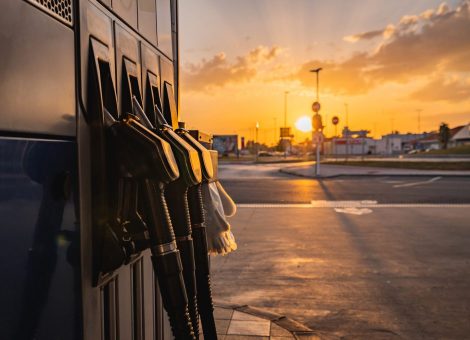Fuel price predictions for 2022
Our fuel price predictions for 2022
In a statement on October 20, US President Joe Biden said he expects gasoline prices to fall in 2022 – but this is difficult to guarantee. The final pump price is impacted by multiple factors not just in the US, but across the globe, and each can affect fuel prices in different ways.
Consumer behavior and demand
We are coming out of two years of depressed demand due to the COVID-19 pandemic. Many countries introduced lockdown restrictions, work-from-home orders, and travel bans. And even in regions that weren’t so strict, there was an amount of anxiety about traveling and socializing that led many to stay at home.
The way people moved changed dramatically. The impact was felt across the globe. In the US demand dropped by 25% in 2020 compared to the previous year, and in Canada, it dropped as low as 33%.
Now, as people globally have eased back into their daily lives, demand has once again picked up. Where we once presumed working from home would be the way forward, many large organizations like Google, Amazon, and Goldman Sachs have instructed employees to return to the office. Demand may not have returned to pre-Covid, peak commuter levels, but it has returned to a more stable point.
Historically – increasing demand will always increase fuel prices. This is because when demand drops – supply drops – but when demand increases – supply is slower to increase, creating an inflated commodity price which then increases consumer pump prices.
OPEC + and oil supply
In July, OPEC + agreed not to increase supply, and hold production steady until April 2022 and so far, they are sticking to that agreement.
At the beginning of the COVID-19 pandemic, the rapid decline in demand led to a huge surplus of oil – and OPEC + decided to limit, and in some cases cut supply, to rescue oil prices from historic lows. Although the demand is increasing from the COVID lows, OPEC + leaders are sticking strong to their plan of not increasing production.
With demand increasing and supply remaining low – the price of crude has shot up. Starting the year at around $40 a barrel, it now sits at around $80 a barrel.
The fuel price outlook for 2022 is dependent on whether OPEC+ decides to stick strongly to their agreement – which could drive prices up higher. Combined with a plateau in consumer demand, global logistics issues, and rising inflation rates – it’s likely that the price of fuel will rise once again.
The cost of crude affects consumers’ fuel prices, but also has a significant impact on fuel margins. With such a competitive industry, it’s often the fuel retailers that take the hit on margins.
How can Fuel Pricing teams prepare?
There are several things that Fuel Pricing teams need to consider when creating their strategies for 2022. With an expectation that prices will rise, and margins may drop, fuel can’t be relied upon to be the only profit driver.
Fuel pricing teams should look at fuel as a lever to impact in-store sales.
Understanding the link between fuel and store sales and considering your site as one complete profit generator is crucial for a future-proof strategy. As consumer behaviors shift – their requirements change. What once generated the most revenue for your sites may now be outperformed by a different offering.
But every service you offer, and every product you sell impacts how your customers interact with you and what they spend. Understanding that on a holistic level for your entire site will help to set your 2022 strategy — and increase your profitability.
Getting the right product mix is imperative to success. Different types of customers require different types of products and services, and particularly in the convenience industry — if you can get it just right, give them what they need and increase the convenience they get from your store — you’ll reap the rewards.
Demographic data that can pinpoint in-store visitors can be used to increase the understanding of your customer profile. And in a world where consumer behavior shifts quickly — the importance of understanding who you serve, why they chose you, and what else they desire, can’t be overlooked.
The real question fuel retailers should be asking in 2022 is…
At a location where convenience store sales outperform fuel – is it the same customer that is buying both – and how do they react to different fuel prices?
If every one of your fuel customers comes into the store to buy additional items, and you increase fuel prices and drive them away – you’ll not only lose your fuel customer but miss out on those high dollars inside sales too – negatively affecting your overall profitability.
Through in-depth data analysis on the fuel-store link, you can better understand what is driving your customer’s behavior, and how you can use fuel prices as a lever to improve c-store revenue.
Optimizing prices for fuel margin is no longer something to be considered in isolation. A fully holistic view that considers the links between fuel sales and store sales, for each of your locations, will help set pricing strategies that use fuel pricing as a catalyst to increasing overall profitability.
Read more articles about:
Fuel pricingSubscribe and get the latest updates
You may unsubscribe from our mailing list at any time. To understand how and why we process your data, please see our Privacy & Cookies Policy
Related posts
Fuel pricing
November 2025. Kalibrate's Canadian Petroleum Price Snapshot
Kalibrate conducts a daily survey of retail gasoline, diesel, propane, and furnace fuel prices in 77 Canadian cities....

Fuel pricing
October 2025. Kalibrate's Canadian Petroleum Price Snapshot
Kalibrate conducts a daily survey of retail gasoline, diesel, propane, and furnace fuel prices in 77 Canadian cities....

